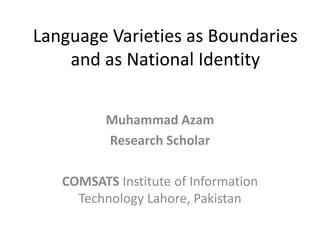
Language varieties as boundaries and as national identity
- 1. Language Varieties as Boundaries and as National Identity Muhammad Azam Research Scholar COMSATS Institute of Information Technology Lahore, Pakistan
- 2. What is Identity • The stable and fixed aspects of selfhood: things that you check off on census forms such as . . . – –Race or ethnicity – –Nationality – –Social class – –Gender – –Age
- 3. What is Identity • Identities are . . . –Stable features of persons that exist prior to any particular situation. • AND –Dynamic and situated accomplishments, enacted through talk, and changing from one occasion to the next.
- 4. Four Kinds of Identities • Master identities . . . – are relatively stable and unchanging: gender, ethnicity, age, national and regional origins. • Interactional identities . . . • – refer to roles that people take on in a communicative context with specific other people.
- 5. Four Kinds of Identities • Personal identities . . . – are expected to be relatively stable and unique. Reference ways in which people talk and behave toward others: hotheaded, honest, forthright, reasonable, overbearing, a gossip, a brown-nose.
- 6. Four Kinds of Identities • Relational identities . . . – refer to the kind of relationship that a person enacts • with a particular conversational partner • in a specific situation.
- 7. Language and Identity • Beside a boundary, a name, a flag, or a currency, what makes a country become a respectable and unique nation is its national language. • National language is a driving force behind unity of the nation’s people, and makes them distinct from other nations – provided you give your language respect.
- 8. Language and Identity • There are two ways of viewing ideologies about identity has become a topic. John Myhill raises the issue, arguing that one ideology is what he calls language-and-identity and the other is an ideology of language-and-territory (Myhill, 1999). – The ideology based on identity is more an emotional connection with language. – While an ideology based on territory means that its proponents argue that in each territory, only one particular language “should be the one used in public circumstances and intergroup communication”
- 9. Language and Identity • There are two ways of viewing ideologies about identity has become a topic. John Myhill raises the issue, arguing that one ideology is what he calls language-and-identity and the other is an ideology of language-and-territory (Myhill, 1999). – The ideology based on identity is more an emotional connection with language. – While an ideology based on territory means that its proponents argue that in each territory, only one particular language “should be the one used in public circumstances and intergroup communication”
- 10. Language and Identity • A language may be important to a group at a symbolic level. – For instance, individuals may collectively lay claim to a language, which they themselves do not speak natively, in order to assert a symbolic identity which will differentiate them from others. – Urdu language for Muslims of subcontinent • Language can constitute an important marker of social identity at various levels of human interdependence, e.g. subcultural or national.
- 11. Language and Identity • It is noteworthy that languages are not inherently ‘good’ or ‘bad’; value and meaning are conferred upon languages by people, which in turn gives rise to pervasive social representations. People may or may not act in accordance with these representations; • for instance, if a group or its language evokes negative social representations, a member of the social or linguistic group may seek social mobility through membership in a more positively evaluated group. • The boundaries of linguistic identity are of course permeable; an individual may choose to leave their original group and gain membership of another by adopting a new language.
- 12. Constructing a national identity • Pre-modern India did not have the concept of a nation. It is after contact with the British that it was imported into Indian discourses. Thus, Syed Ahmed Khan (1817-1899) uses the word “qaum” for all Indians and then, when the Muslims drifted apart from the Hindus, for only Indian Muslims. • But ‘qaum‘ was, and even now is, used by ordinary people for extended class or fraternity (biradari).
- 13. Constructing a national identity • Thus the Pashto-speaking people were described as belonging to the Afghan ‘qaum‘ in India. • Similarly, one could describe one‘s ‘qaum‘ as arain. Even occupational castes, like weaver (juluha) or barber (nai), were described as ‘qaum‘.
- 14. Constructing a national identity • In short, what the nineteenth century Indian reformers did was to subsume a society fragmented along ethnic, occupational and class lines into a modern, basically Western, identity label: nation (qaum). • They created the illusion of unity. They constructed a would-be nation, much in the way described by Benedict Anderson (1983), out of groups which did not see themselves as a nation in the Western sense of the term at all.
- 15. Ideologies and African-American English in the US • African American Vernacular English (AAVE) variety of English language is spoken by African-Americans as a indication of ideology and most consider it one of the dialects of American English, but a variety that has a number of distinctive grammatical features. • The ideologies about African-Americans themselves are reflected in views about this language variety. Some scholarly attempts to study the history of AAVE contribute to a negative bias toward the variety by arguing that AAVE largely shows continuities from various British English dialects.
